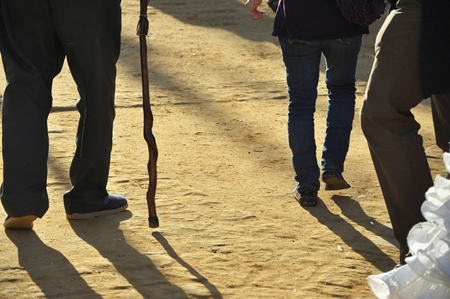13.4 Theoretical Perspectives on Aging
What roles do individual senior citizens play in your life? How do you relate to and interact with older people? What role do they play in neighbourhoods and communities, in cities and in provinces? Sociologists are interested in exploring the answers to questions such as these through a variety of different perspectives including functionalism, symbolic interactionism, and critical sociology.
Functionalism
Functionalists analyze how the parts of society work together to create a state of equilibrium. They gauge how each part of society functions to keep society running smoothly. How does this perspective address aging? Structural functionalists argue that each age performs a specific function in society. Much of the focus in this approach is on how the elderly, as a group, cope with the functional transition of roles as they move into the senior stage of life. How do individuals adapt to the different roles, norms, and expectations of old age, and to their changing physical and mental capacities?
Functionalists find that people with better resources who stay active in other roles adjust better to old age (Crosnoe and Elder, 2002). Three social theories within the functional perspective were developed to explain how older people might deal with later-life experiences.

The earliest gerontological theory in the functionalist perspective is disengagement theory, which suggests that withdrawing from society and social relationships is a natural part of growing old. There are several main points to the theory. First, because everyone expects to die one day, and because people experience physical and mental decline as they approach death, it is natural to withdraw from individuals and society. Second, as the elderly withdraw, they receive less reinforcement to conform to social norms. Therefore, this withdrawal allows a greater freedom from the pressure to conform. Finally, social withdrawal is gendered, meaning it is experienced differently by men and women. Because men focus on work and women focus on marriage and family, when they withdraw, they will be unhappy and directionless until they adopt a role to replace their accustomed role that is compatible with the disengaged state (Cumming and Henry, 1961).
The suggestion that old age was a distinct state in the life course, characterized by a distinct change in roles and activities, was ground-breaking when it was first introduced. However, the theory is no longer accepted in its classic form. Criticisms typically focus on the application of the idea that seniors universally naturally withdraw from society as they age, and that it does not allow for a wide variation in the way people experience aging (Hothschild, 1975).
The social withdrawal that Cumming and Henry recognized (1961), and its notion that elderly people need to find replacement roles for those they have lost, is addressed anew in activity theory. According to this theory, activity levels and social involvement are key to this process, and key to happiness (Havinghurst, 1961; Havinghurst, Neugarten, and Tobin, 1968; Neugarten, 1964). According to this theory, the more active and involved an elderly person is, the happier they will be. Critics of this theory point out that access to social opportunities and activity are not equally available to all, so it over-emphasizes individual choice in its explanation. The theory proposes that activity is a solution to the well-being of seniors without being able to account for how the distribution of access to these social opportunities and activities reflects broader issues of power and inequality in society. Moreover, not everyone finds fulfillment in the presence of others or participation in activities. Reformulations of this theory suggest that participation in informal activities, such as hobbies, are what most affect later life satisfaction (Lemon, Bengtson, and Petersen, 1972).
According to a third approach, continuity theory, the elderly do not drastically change their lifestyles, behaviours, or identities. They make specific choices to maintain consistency in internal personality structures and beliefs, and external structures (e.g., relationships), remaining active and involved throughout their elder years. The focus of this approach is to examine how the elderly attempt to maintain social equilibrium and stability by making future decisions based on already developed social roles (Atchley, 1971; Atchley, 1989). One criticism of this theory is its emphasis on creating a model of “normal” aging, which is inadequate as a description of those with chronic diseases such as Alzheimer’s and tends to treat “non-normal” aging as pathological.
All three theories frame the issue of aging in terms of the function of role adaptation to the aging process. How do individuals adapt their role to the physiological and social effects of the aging process?
Making Connections: Sociology in the Real World
The Greying of North American Prisons

Earl Grimes is a 79-year-old inmate. He has undergone two cataract surgeries and takes about $1,000 a month worth of medication to manage a heart condition. He needs significant help moving around, which he obtains by bribing younger inmates. He is serving a life prison term for a murder he committed 38 years — half a lifetime — ago (Warren, 2002).
Grimes’ situation exemplifies the problems facing prisons today. According to the Annual Report of the Office of the Correctional Investigator in 2011, more than 20% of prisoners are age 50 or older in the Canadian prison population. Age 50 is used as a benchmark of the elderliness of offenders because it is generally recognized that the aging process is accelerated by ten years in prison due to the effects of incarceration. These numbers represent a 50% rise over the last decade (Sapers, 2011). The main factor influencing today’s aging prison population is the aging of the overall population. As discussed in the section on aging in Canada, the percentage of people over 65 is increasing each year due to rising life expectancies and the aging of the baby boom generation.
So why should it matter that the elderly prison population is growing so swiftly? As discussed in the section on the process of aging, growing older is accompanied by a host of physical problems, such as failing vision, mobility, and hearing. Chronic illnesses such as heart disease, arthritis, and diabetes also become increasingly common as people age, whether they are in prison or not. Unfortunately, prisons were not designed with the elderly in mind and those with physical mobility and sight impairments are particularly affected. There is also a threat to their physical well-being from younger inmates as the elderly have little social status within the institution. Ex-inmate Walter Noonan (aged 55) notes that respect for the elderly in prison has declined drastically over the last 10 years. Older inmates are isolated and often afraid of younger inmates who increasingly have drug and psychiatric problems or have gang affiliations and seek to make a name for themselves using violence (Edwards, 2014).
In many cases, elderly prisoners are physically incapable of committing a violent — or possibly any — crime. Is it ethical to keep them locked up for the short remainder of their lives? There seem to be many reasons, both financial and ethical, to release some elderly prisoners to live the rest of their lives — and die — in freedom. However, few lawmakers are willing to appear soft on crime by releasing convicted felons from prison, especially if their sentence was “life without parole” (Warren, 2002).
Critical Sociology

Theorists working the critical perspective view society as inherently unstable, based on power relationships that privilege the powerful wealthy few while marginalizing everyone else. According to the guiding principle of critical sociology, the imbalance of power and access to resources between groups is an issue of social justice that needs to be addressed on the basis of sociological knowledge. Applied to society’s aging population, the principle means that the elderly struggle with other groups — for example, younger society members — to retain a certain share of resources. At some point, this competition may become conflict.
For example, some people complain that the elderly get more than their fair share of society’s resources. In hard economic times, there is great concern about the huge costs of social security and health care. They argue that the medical bills of the nation’s elderly population are rising dramatically, taking resources away from the needs of other segments of the population like education. For example, while funding for education is cut back, funding for medical research increases. However, while there is more care available to certain segments of the senior community, it must be noted that the financial resources available to the aging can vary tremendously by race, social class, and gender.
There are three classic theories of aging within the critical perspective. Modernization theory (Cowgill and Holmes, 1972) suggests that the primary cause of the elderly losing power and influence in society are the parallel forces of industrialization and modernization. As societies modernize, the status of elders decreases, and they are increasingly likely to experience social exclusion. Before industrialization, strong social norms bound the younger generation to care for the older. Now, as societies industrialize, the nuclear family replaces the extended family. With increasingly precarious employment, the struggle to earn a living means that people often have to move away from family to work and the work itself consumes increasing time and energy that might be spent looking after family members. Societies become increasingly individualistic, and norms regarding the care of older people change. In an individualistic industrial or postindustrial society, caring for an elderly relative is seen as a voluntary obligation that may be ignored without fear of social censure.
The central reasoning of modernization theory is that as long as the extended family is the standard family, as in preindustrial economies, elders will have a place in society and a clearly defined role. As societies modernize, the elderly who are unable to work outside of the home will have less to offer economically and are seen as a burden. This model may be applied to both the developed and the developing world, and it suggests that as people age, they will be abandoned and lose much of their familial support since they become a non-productive economic burden.
Another theory in the critical perspective is age stratification theory (Riley, Johnson, and Foner, 1972). Though it may seem obvious now, with a contemporary awareness of ageism, age stratification theorists were the first to suggest that members of society might be stratified by age, just as they are stratified by race, class, and gender. The value of a person (i.e., their status or prestige in society) is determined by their age, which is an ascribed rather than an achieved characteristic. Because age serves as a basis of stratification, different age groups have varying access to social resources such as political and economic power. In this model, the privileges, independence, and access to social resources of seniors decreases based simply on their position within an age-category hierarchy. The elderly experience an increased dependence as they age and must increasingly submit to the will of others because they have fewer ways of compelling others to submit to them.
Moreover, within societies stratified by age, behavioural age norms, including norms about roles and appropriate behaviour, dictate what members of age cohorts may reasonably do. For example, it might be considered deviant for an elderly woman to wear a bikini because it violates norms denying the sexuality of older females. These norms are specific to each age strata, developing from culturally based ideas about how people should “act their age.” On the other hand, thanks to amendments to recent legislation in all provinces (except New Brunswick), Canadian workers no longer have to retire upon reaching a specified age. Age is one of the prohibited grounds of discrimination in employment across Canada.
Age stratification theory has been criticized for its broadness and its inattention to other sources of stratification and how these might intersect with age. Feminist theory argues that an older white male occupies a more powerful role, and is far less limited in his choices, than an older white female based on his historical access to political and economic power. In other words, gender is a key variable needed to understand the issues of aging. Women’s status has traditionally depended much more on youth and physical attractiveness than men’s, so the devaluation associated with aging affects them much more powerfully.
In addition, women’s earnings do not increase at the same rate as men’s in the latter half of their careers so more women enter retirement age with considerably fewer financial resources than men (Garner, 1999). In 2007, the low-income rate for senior, single, unattached women was 14%. About 123,000 senior women living on their own lived in poverty compared to 44,000 men (Townsend, 2009).
Finally, many senior women today were socialized in their experience as daughters and wives to grant the decision-making power to men, especially in the area of financial decision making. When they outlive their spouses, they are often suddenly burdened with decisions and tasks with which they have had no experience. This can be profoundly disempowering, particularly when adult children feel they need to step in and take over. As feminist critique is not simply about drawing attention to the injustice of women’s position in society, the question then becomes, how can senior women be empowered to develop new roles, recognize their strengths, and see themselves as valuable human beings (Garner, 1999)?

Symbolic Interactionism
Generally, theories within the symbolic interactionist perspective focus on how society is created through the day-to-day interaction of individuals, as well as the way people perceive themselves and others based on cultural symbols. This microanalytic perspective proposes that if people develop a sense of identity through their social interactions, their sense of self is dependent on those interactions. A woman whose main interactions with society make her feel old and unattractive may lose her sense of self. But a woman whose interactions make her feel valued and important will have a stronger sense of self and a happier life.
Symbolic interactionists stress that the changes associated with old age, in and of themselves, have no inherent meaning. The biological process of aging does not inherently lead to a specific or predetermined set of attitudes. Rather, attitudes toward the elderly are rooted in society and sustained by ongoing interactions with others.
One microanalytical theory is Rose’s (1962) subculture of aging theory, which focuses on the shared community created by the elderly when they are excluded (due to age), voluntarily or involuntarily, from participating in other groups. This theory suggests that elders will disengage from society and develop new patterns of interaction with peers who share common backgrounds and interests. For example, a group consciousness may develop within such groups as CARP around issues specific to the elderly including health care, retirement security, continuing care, and elder abuse focused on creating social and political pressure to fix those issues. Whether brought together by social or political interests, or even geographic regions, elders may find a strong sense of community with their new group.
Another theory within the symbolic interaction perspective is selective optimization with compensation theory. Baltes and Baltes (1990) argue that successful personal development throughout the life course and subsequent mastery of the challenges associated with everyday life are based on the components of selection, optimization, and compensation. People’s energy diminishes as they age, and they select (selection) personal goals to get the most (optimize) for the effort they put into activities, in this way making up for (compensation) the loss of a wider range of goals and activities. Though this happens at all stages in the life course, in the field of gerontology, researchers focus attention on balancing the losses associated with aging with the gains stemming from aging. In this theory, the physical decline postulated by disengagement theory may result in more dependence, but that is not necessarily negative, as it allows aging individuals to save their energy for the most meaningful activities. For example, a professor who values teaching sociology may participate in a phased retirement, never entirely giving up teaching, but acknowledging personal physical limitations that allow teaching only one or two classes per year. Here, aging is a process and not an outcome, and the goals (compensation) are specific to the individual.
Swedish sociologist Lars Tornstam developed a symbolic interactionist theory called gerotranscendence: the idea that as people age, they transcend the limited views of life they held in earlier times. Tornstam believes that throughout the aging process, the elderly become less self-centred and feel more peaceful and connected to the natural world. Wisdom comes to the elderly, Tornstam’s theory states, and as the elderly tolerate ambiguities and seeming contradictions, they let go of conflict, and develop softer views of right and wrong (Tornstam, 2005).
Tornstam does not claim that everyone will achieve wisdom in aging. Some elderly people might still grow bitter and isolated, feel ignored and left out, or become grumpy and judgmental. Symbolic interactionists believe that, just as in other phases of life, individuals must struggle to overcome their own failings and turn them into strengths.
Finally, exchange theory (Dowd, 1975) suggests that one’s status and role identity within social relationships depend on an ongoing exchange of social resources such as effort, time, money, support, and companionship. The norm of reciprocity dictates that what one gives in a relationship should be balanced by what one receives in return. There is an implicit cost/benefit analysis that underlies the dynamics of social relationships in which individuals calculate the costs of their contributions to the relationship (in terms of effort, etc.) against the benefits and rewards they receive in return. Inasmuch as relationships are based on mutual exchanges, as the elderly become less able to exchange resources, or their resources diminish in value, they see their social circles diminish. There is less benefit for others to exchange with them. In this model, the only means to avoid being discarded is to engage in resource management, such as maintaining a large inheritance or participating in social exchange systems via child care.
In fact, the theory may depend too much on the assumption that individuals are calculating. It is often criticized for affording too much credit to material exchange and devaluing nonmaterial assets such as love and friendship. Nevertheless, many tensions in elder care stem from the perception of an unequal exchange of resources, especially when the resources exchanged are of different types (Collins, 2008). Randall Collins describes the relationship between a caregiver, who acts out of love, sympathy, or altruism to care for an elderly person and thus receives rewards in the form of social esteem, and the elderly person who receives care but often has control over financial resources. Over time the provision of care becomes routine, the caregiver gets reduced emotional rewards from playing the altruistic role (begins to burn-out) and begins to feel that the demands of care take away from other life activities. On the other side, a dependent elderly person might see the care-giver’s attention waning and seek to exercise more control over them, just to have social interaction that is otherwise lacking, perhaps even by making the caregiver feel guilty about not living up to their altruistic self-image. A toxic social exchange pattern can build up leading to elder abuse.
Media Attributions
- Figure 13.16 It’s all about love by Candida.Performa, via Flickr, is used under a CC BY 2.0 licence.
- Figure 13.17 D block, alcatraz by Claire Rowland, via Flickr, is used under a CC BY 2.0 licence.
- Figure 13.18 A Grandmother and her Grandchildren in Mgona, by Khym54, via Flickr, is used under CC BY 2.0 licence.
- Figure 13.19 la feria a dos velocidades by Ignacio Palomo Duarte, via Flickr, is used under CC BY 2.0 licence.

